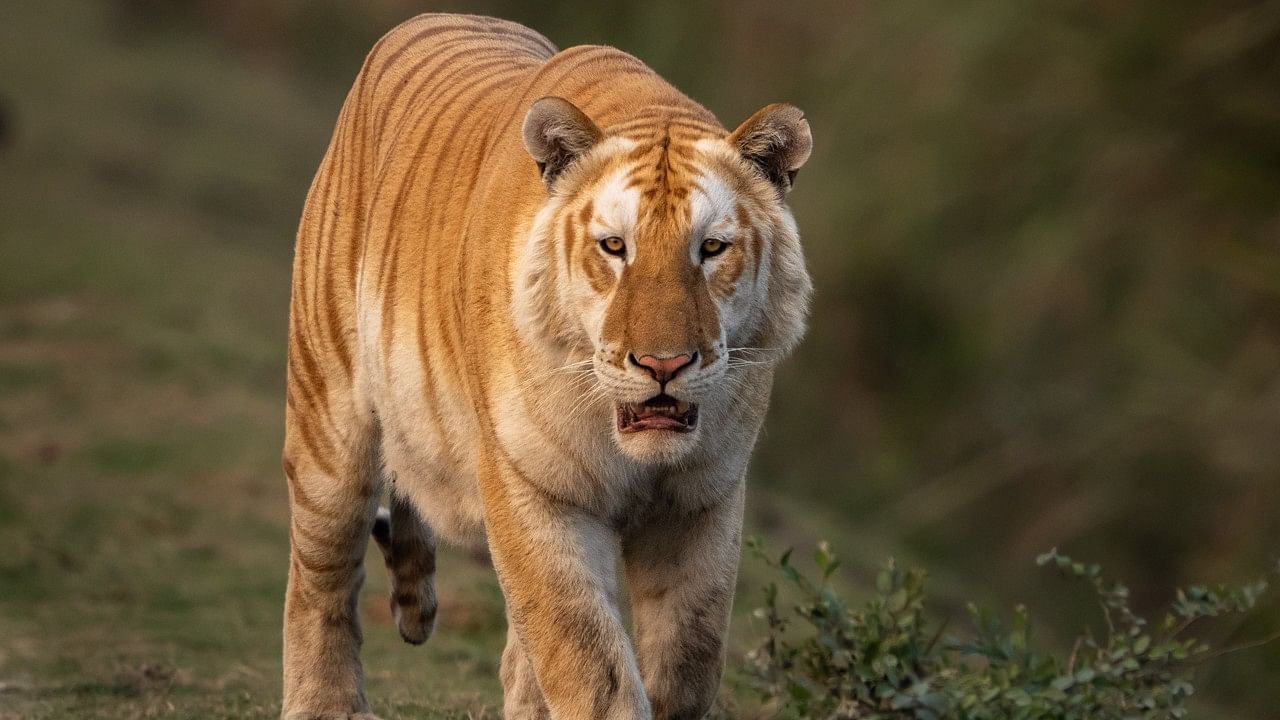
The photo of the Golden Tiger captured on camera in Assam.
Photo credit: Gaurav Ramnarayanan, Coimbatore, Tamil Nadu.
Guwahati: The 'rarest' golden tiger was captured on camera in Assam's Kaziranga National Park and Tiger Reserve (KNPTR) after three years by a Coimbatore-based tourism professional on Wednesday, bringing cheers to many.
25-year-old Gaurav Ramnarayanan was out leading a private photo tour with two of his tourist clients from Australia in western side of the park's Bagori range when they suddenly had the rare glimpse. "It was around 4pm. We heard some warning sounds of barking deers. Our tour guide Buddheshwar Konwar, who spotted it at a distance, stopped the jeep. In a matter of seconds, we saw the golden tiger from about 600 to 700 meters away. I started clicking as many photographs as I could," Gaurav told DH on Thursday evening.
"Suddenly the tiger started moving towards us. It came as close as 60 to 70 meters. I did not stop clicking photographs. It was a really thrilling and unforgettable moment for all of us," Gaurav said.
Gaurav runs a travel company, www.thewilside.in and was leading a private photo tour for his Australian guests in the park. "It was not my first visit to Kaziranga. But I feel lucky to have a glimpse of the rare golden tiger for the first time," he said.
Informing about the development, director of the park, Sonali Ghosh on Thursday said the "rarest" adult male Bengal tiger morph (the golden morph) was seen in the park after three years.
"The golden phenotype (as demonstrated by the Kaziranga tiger) is a rare recessive trait," she said.
Ghosh said the trait is being investigated through non-invasive scat sampling and DNA mapping by scientists Prof. Uma Ramakrishnan and her team at National Centre for Biological Sciences, Bangalore. "As both pseudo-melanistic and golden phenotypes are expressed as recessive traits, their occurrence in natural population suggests an even large number of heterozygotes in the population, which can only be detected through genetic analyses (as the heterozygotes look the same as a normal tiger). However, if such heterozygotes are present in numbers less than expected from theoretical values, it might suggest a lack of genetic connectivity. In such a case, it might be critical to maintain habitat connectivity to sustain the natural variation and reduce the threat of extinction," Ghosh said.
"Majestic Beauty!" Assam CM posted on 'X' on Thursday with a photograph of the golden tiger clicked by Ramnarayanan.
Nothing to celebrate?
In July 2020, a "golden tiger" was sighted in Kaziranga, which the experts described as a tiger with colour aberration. A photograph of the tiger was shared by IFS officer Parveen Kaswan. The park authorities then said three such tigers/tigress with similar colour aberration were earlier spotted in Kaziranga.
But the park officials then told DH that golden colour was nothing to celebrate as far as the future of tigers was concerned.
The “golden tiger,” the park officials had suggested, was an example of unusual colour aberration, and it could be due to excessive inbreeding, one of the main reasons for population decline among tigers in the wild.
Ghosh on Thursday, however, said, "But to link inbreeding to genetic variation is far-fetched."
"Diverse forms of pigmentation phenotypes are known in many species of birds, butterflies, wild ungulates, domesticated animals and also in humans. Phenotypic variations are driven by evolutionary forces such as selection and random genetic drift," Ghosh said.
The KNPTR director further said tigers have a unique striping pattern that is known to exist in several coat colour variants. "The most famous being the pseudo-melanistic (or darker) morph that is found in the wild at Simlipal Tiger Reserve in Odisha. The white tiger pelage is a recessive trait and such individuals are now only confined to zoos."